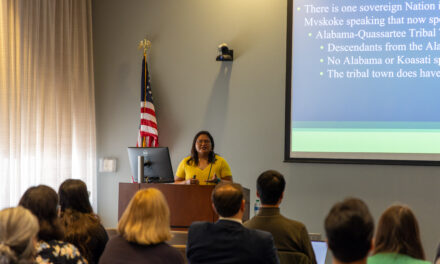Researchers at Emory and the Georgia Institute of Technology (Georgia Tech) published a paper on Oct. 21 detailing an artificial intelligence-based tool that is able to predict COVID-19 symptoms and suggest specific FDA-approved drugs.
These researchers developed MOATAI-VIR (Mode of Action proteins and Targeted therapeutic discovery driven by Artificial Intelligence for Viruses) in the hopes of improving COVID-19 patient outcomes.
Regents’ Professor in the School of Biological Sciences at Georgia Tech Jeffrey Skolnick said that the algorithm can predict the most probable drugs for a doctor to prescribe to treat a disease.

Photo Courtesy of the Georgia Institute of Technology
“We wanted to apply this to COVID-19, because we’ve seen so many complications,” Courtney Astore said, who currently is a Bioinformatics PhD student at Georgia Tech.
The study was conducted by Astore, Skolnick, Senior Research Scientist at Georgia Tech Hongyi Zhou and Associate Professor at the Emory School of Medicine Joshy Jacob.
Astore listed loss of smell, blood clotting and cytokine storms as the main complications the research team was hoping to target with effective treatments.
Skolnick said most diseases are comorbidities, meaning that one disease can often facilitate another disease, adding that the malfunction of many known proteins can lead to disease.
In 2020, Skolnick’s team published a paper on MEDICASCY, an algorithm created to elucidate driver proteins that are likely associated with a given disease. Astore explained that there are approximately 3,600 diseases with a known mode of action proteins (proteins that specifically lead to diseases if they do not function correctly) that the algorithm can predict comorbidities with other diseases.
Skolnick’s research team was able to use the driver proteins predicted from MEDICASCY to help develop MOATAI-VIR technology, which determines disease and protein-pathway relationships in order to determine which repurposed FDA-approved drugs will be most appropriate to treat a given illness.
“The SARSCoV-2 protein interacts with a human protein that is associated with a specific complication and that’s how the common prediction is made,” Skolnick said.
Out of the 30 known complications of SARSCoV-2, the tool can predict 24 out of 26 major complications, Skolnick reported. The technology is also 60-75% correct at predicting the correct drug or course of treatment for a specific disease.
“We built an algorithm that makes a hypothesis that retrospectively turns out to be true,” Skolnick said. “On average, the proteins that are common for a bunch of comorbid diseases are the ones you want to target with drugs.”
This in turn can aid clinicians to find drugs that can treat these comorbidities.
“None of these algorithms are infallible,” Skolnick said. “They should be used as a clinical guidance tool as an intelligent guess with probabilities that it [a drug] will work.”
The MOATAI-VIR methodology algorithms are now available to the public online.
“The newest release has been the LeMeDISCO web service, where people can input their own pathogenic gene sets and predict what comorbidities are associated with their gene set,” Astore said.
The future of medicine lies in this research, according to Astore. As the COVID-19 pandemic continues to unfold, new scientific discoveries will continue to save lives and help clinicians take preventative measures.
“One of the ugly predictions that comes out of this algorithm is that it looks like SARSCoV-2 is pretty [cancer causing],” Skolnick said. “If you ever had a reason to seriously consider getting a vaccine, this is it.”
Assistant Multimedia Editor & Atlanta Campus Desk | Lauren Baydaline (she/her 23C) is from Los Angeles, California, majoring in biology and anthropology and human biology on the pre-med track. Outside of the Wheel, she is working in Dr. Escobar's lab and as a classroom technical assistant. Baydaline is also an avid volunteer for the Glendale YMCA. Her hobbies include cooking, reading, selling clothes on Depop, and working out.



